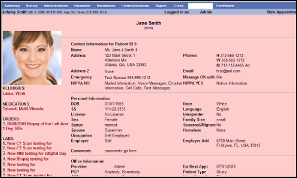William Zurhellen, MD, FAAP is a pediatrician at Putnam Valley Pediatrics PC of Putnam Valley, NY.

Provide me a bit of background on your practice.
This is a two-pediatrician private practice in Putnam Valley, New York, which is a suburb of metropolitan New York, about 45 minutes to an hour north of New York City. It was established in 1975 by me. It’s a community-based, ambulatory general pediatric practice.
I understand you’re using a homegrown EMR. What’s the history there?
I developed an interest in computers way back when the Tandy Model 1 came out. I started writing what was then BASIC from Dartmouth, BASIC programs for that. We wrote a financial program in 1984 and immunization program in 1987 and then launched what would be our current EHR in 1999. It’s had revisions, but the basic format has been the same for 20 years.
Are you the only practice using it or has it been used other places?
There are several other practices that are still using it, although each practice had the right from Y2K on to essentially alter it themselves. In other words, it was a research project on our part and we had other pediatricians — it’s only pediatrics — who wanted to use it. So we installed it for them and set it up for them and then they manage it. It’s self-managed.
So it does general functions like the prescription writing, tracks immunizations, all that?
It does prescription writing. However, with the changes in New York state law, we can’t use it any more because it required the use of micro-printing. Of course, removing the e-prescribing, the goal is to eventually merge an e-prescribing software with it.
More likely, when the right new system comes along that works as well or better than ours, then we will probably migrate to that, only because the only support for our system is me and I’m 63. I don’t want to be supporting the software when I’m 85.
I understand you’re a member of a CCHIT work group.
I’m part of the Child Health expert panel.
I’m assuming your homegrown EHR is not CCHIT-certified?
No. There’s no intent at this point to have to go and qualify for ourselves because there’s no point in spending $30 to $40 thousand on a regular basis to certify ours.
Do you think CCHIT certification should be a requirement to qualify for government funding?
That’s a big, heavy-duty topic. I think government funding is going to help others purchase EHR technology because I think cost and price is a major issue. I think the government needs to be able to set specifics to prevent people from buying a $10 piece of software that does one thing and say, “We have an EHR.” The only current way to do that is either for the government to come out and spell out things that it must be able to do, but then it has CCHIT that’s already doing it. So, I think it’s reasonable to do that.
On the other hand, I’m not sure, and this is just my personal opinion, that the current software out there is what we all need in the first place.
In other words, there’s not the perfect software?
I wouldn’t buy any one of them right now. That’s because I think most current vendor software offerings are really designed around pay-for-performance and documentation to get paid. I’m a firm believer that electronic health records should be designed to improve the health outcomes of the patient and that payment is a derivative of that, but none of the current systems really track outcomes or healthcare.
Until we retool, in a sense, and prioritize the software in such a way that when you build up a five-, or ten-, or twenty-year database of patient function, you can look at it and see if this type of care enhanced or didn’t enhance the patient’s clinical outcome. There’s never been any evidence that pay-for-performance has any quality impact on any health outcomes, in the long run, on individual patients.
Does your software do that type of tracking, reporting, capturing?
To a certain extent, yes. Not as much as I’d like, but I’m limited by the fact that we’re using UNIX and twenty-year-old data structured software.
And no plans to do a rewrite?
Not at this point. I would rather buy something or acquire something that’s going to be supported by someone other than myself personally. So there will come a time for a transition. But if I wanted to, yeah, I’d sit down and take a year or two years off and write something and become a vendor myself. But no, I’m not interested in that.
Has the promise of money through ARRA and other pay-for-performance programs changed your focus at all in terms of technology adoption?
No, because I think the basic original tenet of trying to move medicine into the electronic world is incorrect. I’m not sure how they’re doing it is correct. The entire ARRA is a trade for information. We’ll give you money to put in records, but in return, we want you to supply us with performance data. Performance does not equal quality.
How is your current EMR helping you do research?
It helps us run the practice, and that by itself is the research. It allows us to track patients, follow health reminders — it pops up when we have pre-indicated that we needed it — it sorts, selects patients based on criteria that we set.
The problem is that, for example, if you were talking about children with asthma, there’s really no great case-mix or outcome definition that’s standardized. Not only that, most information systems are based on tracking an encounter, not an episode of care. That is, if a child has an asthma attack that goes on for two weeks and you try A, you try B, and you finally get it under control, you need to look at that whole episode, not just today’s office visit, last week’s office visit; because then the human being has to manually build a picture of an episode, whereas it could be built into information systems.
How are you inputting information?
Keyboard.
Do you have PCs in every exam room?
Well it’s UNIX-based, so we have a central server, and we have Wyse 350 terminals in every room. It’s all working off the same system. Everybody uses it to run our financial, our scheduling, our messaging; all the background services of the practice.
What would you say if a doctor came to you and said, “I want to go write my own software like you did?”
Twenty years ago, great idea. These days, no — it’s a lot more complicated than that. I mean, a person could, but my own feeling is — and this is speaking as a pediatrician — I’m not a great fan of the idea of what people consider, currently, interoperability. Interoperability, conceptually right now, is the ability to exchange bits of information between one system or another.
If I take care of a child for twelve years and they moved to a friend’s practice in California, it doesn’t do any good for long-term records to send him a snapshot or bits of information. That person should have access to that child’s record in the form that I put it in so he can continue to build on it. That is, whether you call it interoperability or exchange, it’s a different concept because right now people are talking about CCRs, where you can exchange certain amounts of information from on to the other.
It still parses it and summarizes it, so it’s no better than a patient record now where I might have a full chart. Then when the chart moves, I send a summary of the problem list and immunizations. That’s great, but it doesn’t supply any background data on the patient over a year, so it’s not useful in terms of looking at outcomes in healthcare management.
My own feeling is that if we could get a single data structure and let vendors compete on the user interface, then all records would be compatible with all others. For example, say I pick NextGen for my office and I install NextGen. Say, five years from now, NextGen wants to raise its yearly maintenance to $30,000. I have no choice but to pay it because if I said, “No, I’m not going to go. I’m going to switch to Vendor X.” Well, Vendor X can’t access the data structure. They’d have to write a completely new conversion program to take all the data from NextGen and convert it into a format that they can use. That costs money.
Or, if a vender decided, “Hey, it’s not worth it anymore. I’m selling out,” or discontinuing, a doctor’s going to be left up the creek with a set of records with no support anymore because it’s not interchangeable. That’s probably, more than money, at least in pediatrics, the biggest hold-back — the fact that obsolescence and being dependent on a single vendor is not a nice situation for anyone to be in.
What if every TV station had their own proprietary mechanism of sending out TV screens so you got a computer that would get NBC, but it wouldn’t get ABC? It’s the same thing, that there’s no real standardization.
I think that if we address the issue of true standardization, whether you did it on site or did it as a centralized data structure, the patient should have a patient record that starts prenatally and goes through life, and shouldn’t have 15 different ones in different sites.
I mean, we’re talking about healthcare now, not getting paid. That’s what I meant earlier by the current systems are designed for an individual physician or an individual practice and focus on documentation for payment. That’s not quality, not from a patient perspective.
Last question here – your opinion on why EMR adoption is so low?
I think money plays a role in it. Standardization plays a role in it, for fear of, “I’m going to be left holding the bag if somebody decides not to support my system any more.” And if I’m dependent on a single vendor, then I can no longer say, “Well I’m not going to pay the bill any more. You’re much too high for what you’re doing.”? Well, then I’m outta here. You can’t do that when you’re dependent on a single type of software system. There’s no other industry that operates on the same basis.
If you have an inventory system done by one company and you want to switch to SAP, bang — there’s a certain amount of standardization on it. So I think doctors are afraid. There are 315 different systems out there, all running. They may work individually well, but you can’t exchange them.
We’re talking about the ambulatory sector, you see. Most primary care physicians are used to the idea of exchanging a document with an orthopedist and getting a document back from an orthopedist. But within the ambulatory sector, pediatricians want to be able to send the patient’s chart to the new pediatrician, not just a note. I think interoperability’s been taken as any system is equivalent to any other one, when in reality, you don’t operate that way. The child’s entire health record should go.
If a woman had breast cancer and had been getting three years of chemotherapy out of Sloan-Kettering and then she moves to Phoenix, what do they do? Send just a summary document? They have to send the entire treatment summary, and it has to be usable and readable by the receiving system.
So, I think part of the holdup is the absolute cost. I think part of the holdup is the fact that there’s no real perception of what real interoperability or exchangeability or standardization is. I don’t think the vendors are interested in, in my own experience, in talking to the EHRA, or what used to be EHRVA. They’re making quite a bit of money selling systems that are documentation to get paid.
They’re not looking at changing, unless we change the perspective that the purpose of the EHR is not for the physician, it’s for the patient. Well, pediatricians are different than anybody else. We’re the only ones taught to manage patients and practice true preventive care. So these elements, the fact that it has to be designed for quality care, the information has to be mobile. That’s much more critical to us than it seems to be for adult physicians. That’s just us – we’re different.













The article about Pediatric Associates in CA has a nugget with a potentially outsized impact: the implication that VFC vaccines…